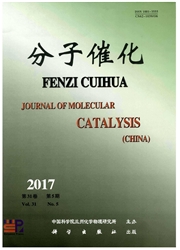

 中文摘要:
中文摘要:
采用不同Br源制备Fe改性溴氧化铋(Fe.BiOBr)并结合x一射线衍射、x射线光电子能谱、扫描电镜、紫外可见漫反射和荧光分光光度计对催化剂进行表征.发现以NaBr作Br源能成功得到Fe掺杂BiOBr,Fe进入BiOBr品格内部形成了Bi-O-Fe或Br—O—Fe键,Fe含量约为0.20(Fe与Bi原子比),禁带宽度为1.92eV.相同制备条件下以表面活性剂十六烷基三甲基溴化铵(CetrimoniumBromide,CTAB)为溴源只能得到单纯的BiOBr,禁带宽度为2.78eV,按其含Fe量将两种Br源制备的BiOBr分别命名为Fe0.2-BiOBr和Fe0-BiOBr.在可见光下(A≥420nm)降解罗丹明B(RhodamineB,RhB)发现Fe0.2-BiOBr具有更优越的可见光活性.结合电子自旋共振及自由基捕获等实验,推测Fe3d轨道参与了BiOBr的价带和导带形成,使其禁带宽度减小,电子空穴复合率降低,其光催化氧化机理主要涉及超氧自由基(O2-)和空穴(h+).
 英文摘要:
英文摘要:
Fe dopped BiOBr was synthesized via a facile hydrothermal method, where using sodium bromide (NaBr) and cetrimonium bromide (CTAB) as the raw materials. All the samples were characterized by using vari- ous methods including X-ray diffraction, Scanning electron microscopy, UV-Vis diffuse reflectance spectra and Flu- orescence spectrophotometer, respectively. The result showed that in the same preparation conditions, Fe doped BiOBr could be gained when NaBr was used as bromine source, Fe entered into BiOBr crystal lattice and formed the new bounds of Bi-O-Fe or Br-O-Fe, iron content was approximately 0.20 by EDS, the band gap was 1.92 eV. PL analysis showed that Fe doped BiOBr helps reduce recombination rate of photoproduction hole and photoproduction electronic. However, we got merely pure BiOBr when CTAB was used as bromine source, XPS and EDS detection of ferric content of only O. 07, the band gap was 2.78 eV. Samples were named F0. 2-BiOBr and Fe0-BiOBr accor- ding to the content of Fe. It was indicated that Feo.2-BiOBr(k =0. 109 min-1 ) had the better photocatalytical activi- ty than Fe0-BiOBr ( k = 0. 055 min-1 ) under visible light ( A I〉420 nm) degradation of Rhodamine B (RhB). The sam- ples were proved to be an efficient and relatively stable photocatalyst under six recycling experiments. It was indica- ted that the visible-light photocatalytic activity of Fe0.2-BiOBr was attributed by both crystal lattice iron and surface iron oxides by the Electron spin resonance results and free radical scavenging experiments. Fe 3d orbitals was in- volved the formation of valence band(VB) and conduction band(CB) of Fe-BiOBr and superoxide radical( O2"-) and valence band hole( h+) acted as the main reactive oxygen species.
 同期刊论文项目
同期刊论文项目
 同项目期刊论文
同项目期刊论文
 BiOBr Activation by UV and Visible Irradiation: A Telling Difference in Oxygen Source during Photoca
BiOBr Activation by UV and Visible Irradiation: A Telling Difference in Oxygen Source during Photoca Degradation of ciprofloxacin in aqueous bismuth oxybromide (BiOBr) suspensions under visible light i
Degradation of ciprofloxacin in aqueous bismuth oxybromide (BiOBr) suspensions under visible light i Degradation of Microcystin-LR in water: Hydrolysis of peptide bonds catalyzed by maghemite under vis
Degradation of Microcystin-LR in water: Hydrolysis of peptide bonds catalyzed by maghemite under vis Photocatalytic properties of hierarchical BiOXs obtained via an ethanol-assisted solvothermal proces
Photocatalytic properties of hierarchical BiOXs obtained via an ethanol-assisted solvothermal proces Moderate valence band of bismuth oxyhalides (BiOXs, X = Cl, Br, I) for the best photocatalytic degra
Moderate valence band of bismuth oxyhalides (BiOXs, X = Cl, Br, I) for the best photocatalytic degra Bismuth oxybromide promoted detoxification of cylindrospermopsin under UV and visible light illumina
Bismuth oxybromide promoted detoxification of cylindrospermopsin under UV and visible light illumina Comparing the degradation of acetochlor to RhB using BiOBr under visible light: A significantly diff
Comparing the degradation of acetochlor to RhB using BiOBr under visible light: A significantly diff Moderate valence band of bismuth oxyhalides (BiOXs, X=Cl, Br, I) for the best photocatalytic degrada
Moderate valence band of bismuth oxyhalides (BiOXs, X=Cl, Br, I) for the best photocatalytic degrada Heterogeneous degradation of toxic organic pollutants by hydrophobic copper Schiff-base complex unde
Heterogeneous degradation of toxic organic pollutants by hydrophobic copper Schiff-base complex unde 期刊信息
期刊信息
